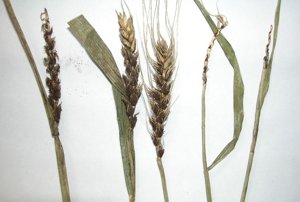Diseases
Ustilago tritici (Pers.) Rostr. - Loose smut.
Classification.
Class Basidiomycetes, subclass Teliobasidiomycetidae, order Ustilaginales, family Ustilaginacea, genus Ustilago.Synonyms.
Ustilago tritici (Pers.) Jens., U. vavilovii Jacz.Biological group.
Obligate wheat pathogen.Morphology and biology.
Loose smut is most obvious at wheat heading. As a result, the spike is entirely destroyed except for the rachilla, and the spikelets of colonized heads become a mass of olive-black spores. Sometimes narrow strips of sporiferous fungus are observed on upper parts of stem and leaves. The loose smut fungus survives as a dormant mycelium within the embryo of wheat seed. The pathogen is activated when the infected seed germinates, and it expands toward the growing point of the plant. When the plant begins to form a head, the fungus invades the whole young head tissue except for that of the rachilla. Later mycelium forms teliospores, and the head produced by infected plant contains black teliospore masses in place of the grains. The spores are easily spread by wind onto neighboring healthy plants and infect flowering plants. The windborne teliospores fall on the open flower stigmas and geminate. Upon germination the teliospores produce a basidium (promycelium) forming basidiospores (sporidii). The fusion of compatible monokariotic cells occurs. Copulated basidial cells yield infectious dikaryotic hyphae which penetrate the ovaries. Seed bud is infected, but grains containing fungus hyphae in embryo are developed. Teliospores of U. tritici are spherical, echinulate, olive-black, 5 to 9 mkm in diameter.Distribution.
Loose smut occurs in all countries where wheat is grown. In Russian Federation the disease is widely distributed in spring wheat growing areas. In southern regions the fungus also damages winter wheat.Ecology.
Temperatures 22 to 27.C and humidity 60 to 95% are favorable for both teliospore germination and mycelium development. The fungus stops developing in plant tissues under temperatures of 7 to 8.C, and that is why winter wheat is less damaged by smut than spring wheat.Economic significance.
The fungus affects species of the genera Triticum, Hordeum, Secale, Aegilops, Elimus, Agropiron, Elytrigia, Haynaldia. This disease, however, has a potential to cause significant yield losses if control practices are ignored. Yield loss is directly proportional to the incidence of smutted heads. Annual disease development is 0.1 to 1%, but it increases in cases of absence of protection measures. Protection measures: seed dressing and resistant varieties.Reference citations:
Druzhinina A.E., Krupnov V.A. 2000. Influence of environmental conditions for infection of spring wheat by loose smut in Volga region. Doklady Rossiiskoi academii selskokhozyaistvennykh nauk, 2: 16-18. (In Russian)Karatygin I.V. 1986. Agents of cereal smut. Leningrad: Nauka. 112 pp. (In Russian)
Krivchenko V.I. 1984. Resistance of cereals to smut fungi. Moscow: Kolos. 304 pp. (In Russian)
Sanin S.S., Nasarova L.N., Sokolova E.A., Ibragimov T.S. 1999. Health of cereal fields. Zashchita i karantin rastenii, 2: 28-31. (In Russian)
Tymchenko L.F. 1969. Loose smut of spring wheat in Non-Chernozem zone. PhD Thesis. Moscow: State Lomonosov University. 20 pp. (In Russian)
Zakharenko V.A., Kuzmichev A.A., Plotnikov V.F., Pavlyushin V.A., Novozhilov K.V., Dolzhenko V.I., Nasedkina G.A.; Grichanov, I.Ya. 2000. Extent and trends of species composition and population structure changes, areas of harmful and useful organisms complexes, and forecast of dangerous phytosanitary situations in Russian regions. St. Petersburg: RASKhN. 1-100 p. (In Russian)
© Gultyaeva E.I.


